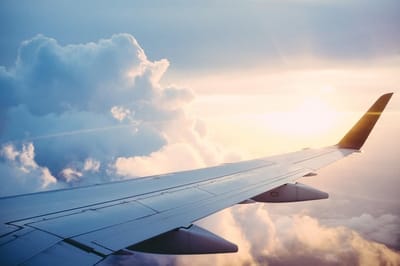flight
flight 1

Controlled Airspace
Airspace is that area of the atmosphere owned and in
control by a country over its zone which includes water spaces. Controlled airspace
can be defined as that an airspace which lies within where the borders of air
control traffic services are delivered. The extent of airspace control depends
on the different classes of airspace. There are different classes of
controlled airspace ranging from class A to E. These classes will exhibit different
control levels by the federal aviation administration of different states. In
this article, you will learn more about the different classes of controlled
airspace. View https://www.flightliteracy.com/controlled-airspace/
Class A of controlled airspace is categorized as that
airspace that is 18,000 feet above the sea level within the borders of a
country. This also includes the water space and coastal line that lies within
the borders of the country. All airspace operations that are under this class
are regulated by what is called instrument flight rules. Here all flights are
provided with air traffic control services and they are always separated from
one another. Flights in class B controlled airspace share the controlled IFR
with class A controlled airspace and also provided with the air control
services and separated from each other. In terms of feet from the ground, the class is
10,000 feet above the surface of the earth.
Class C controlled airspace is the airspace that is above 4,000 feet above the surface of the
airport. This class is busy and has an operational control tower, also serviced
by a radar approach control which is not the case when looking at controlled
airspace classes A and B. Most people describe the outlook of class C
controlled airspace as a wedding cake that is turned upside down. Class D
controlled airspace is the one that surrounds minor airports that also have control
towers and it extends up to 2,500 feet above the sea level. learn more here
Class E airspace is that airspace that offers adequate space
for controlling safely and also for separating airplanes during the instrument
flight rules operations. In most countries like the United States, the big area
of their airspace is selected as class C controlled airspace. This class of
controlled airspace begins from 14,500 feet mean sea level. Finally, there is a
class that is called class G uncontrolled airspace, which is that airspace that
hs not been selected as class A, B, C, D or E controlled airspace.
More info https://www.youtube.com/watch?v=G_SYa2s6rwk&t=3s
flight 2

Things to Note When Considering Flight Trainings
Technological advancements have brought with them so much and thank s there is so much to learn. The air transport is one of the greatest technological advancements witnessed in our world today. It is quite a complex thing to understand and for those who want to know more have been forced to seek the help of flight Training session. It is important to note that although the internet has so much information concerning almost everything, sometimes it is limited as some of the information required may be quite technical and may actually require a one on one ne session so that it is explained exhaustively. Find out more here
Flight Trainings have come on board to help understand complex and seemingly hard concepts about flying. Most of these trainers do not offer it for free and therefore as one is looking for a good flight trainer they should consider the company at charged and determine whether they can afford the service or not. It is important to ensure that they do not compromised see on quality even as they are looking for affordable and cheap services.
These flight Trainings are quite beneficial as they really help the general public and the normal man who has not gone to flying school or the physics class. They help these people get a better grasp of how flying a plane is done and the dynamics involved. Read more here
It is also important to ensure that one goes to a flying trainer that is credible and reliable. One should ensure that the trainer is licensed to offer such lessons and the lessons gotten would actually be of help. In order to be very sure of these, an individual may try looking at the trainers website and see the kind of lessons offered. It is also important to check the experience of the flying trainer because the more experienced they are the better the lesson are likely to be.
Another way of selecting the best trainer is by ensuring that one looks at online ratings to see how the trainer has been rated by its customers and client. The higher the ratings for the flying trainer the better. It is also good to consider the advice of family and friends who have hired the services of a flying trainer before. Their advice would be material in decision making regarding the trainer to pick because they would give advice based on previous interactions with such trainers.
More details https://www.youtube.com/watch?v=G_SYa2s6rwk&t=3s
Technological advancements have brought with them so much and thank s there is so much to learn. The air transport is one of the greatest technological advancements witnessed in our world today. It is quite a complex thing to understand and for those who want to know more have been forced to seek the help of flight Training session. It is important to note that although the internet has so much information concerning almost everything, sometimes it is limited as some of the information required may be quite technical and may actually require a one on one ne session so that it is explained exhaustively. Find out more here
Flight Trainings have come on board to help understand complex and seemingly hard concepts about flying. Most of these trainers do not offer it for free and therefore as one is looking for a good flight trainer they should consider the company at charged and determine whether they can afford the service or not. It is important to ensure that they do not compromised see on quality even as they are looking for affordable and cheap services.
These flight Trainings are quite beneficial as they really help the general public and the normal man who has not gone to flying school or the physics class. They help these people get a better grasp of how flying a plane is done and the dynamics involved. Read more here
It is also important to ensure that one goes to a flying trainer that is credible and reliable. One should ensure that the trainer is licensed to offer such lessons and the lessons gotten would actually be of help. In order to be very sure of these, an individual may try looking at the trainers website and see the kind of lessons offered. It is also important to check the experience of the flying trainer because the more experienced they are the better the lesson are likely to be.
Another way of selecting the best trainer is by ensuring that one looks at online ratings to see how the trainer has been rated by its customers and client. The higher the ratings for the flying trainer the better. It is also good to consider the advice of family and friends who have hired the services of a flying trainer before. Their advice would be material in decision making regarding the trainer to pick because they would give advice based on previous interactions with such trainers.
More details https://www.youtube.com/watch?v=G_SYa2s6rwk&t=3s
flight 3

How to Pick the Best Flight Training Institution
One of the best feelings in life is to finally decide on what you want to do with your life. Even more, one that gives you the best feeling is doing something exciting and fulfilling. One of the things is the decision to become a pilot and earn some basic flight skills. When you have decided on the time you will go for the training, you have already saved enough money for the training and the only thing remaining is to choose the flight school to attend, you know that you are almost getting to the point where you will achieve your dreams. One of the most important factors that will determine the school that you will acquire the skills is the area where you reside. see page
If you live in an area that is remote and sparsely populated, such as the rural area, it means that you will have limited options for the school that you choose to do your training. However, if you live in a highly-populated area, such as a city or a town, chances are high that your options for the schools you would want to attend are many. Nevertheless, regardless of the school that you chose, it is vital to understand that all of these schools must be accredited by institutions that follow are set code of rules and regulations that they are obliged to obey. It means that you will be taught all that has been stipulated for you to get the license.
At the time of choosing the school that you want to attend, you need to decide the type of training you want. For some, the training they would want is for recreational purposes whereas, for others, they would love to do the commercial flights. There are those schools that are specialized in commercial flying. However, regardless of the training that you want to get, you will have to begin with the fundamental skills. For a lot of the people, they get the flying license and then go on to choose what they want to do later, based on their desires and abilities. Some stop at this level. View https://www.flightliteracy.com/controlled-airspace/
To get the appropriate school, you need to consider several factors. You need to find out whether they have accreditation from the relevant bodies. While at it, you need to look at their record and determine whether it is proven to be an accomplishing institution. Also, find out if they have the best equipment and whether they have affordable costs.
More on https://www.youtube.com/watch?v=G_SYa2s6rwk&t=3s
One of the best feelings in life is to finally decide on what you want to do with your life. Even more, one that gives you the best feeling is doing something exciting and fulfilling. One of the things is the decision to become a pilot and earn some basic flight skills. When you have decided on the time you will go for the training, you have already saved enough money for the training and the only thing remaining is to choose the flight school to attend, you know that you are almost getting to the point where you will achieve your dreams. One of the most important factors that will determine the school that you will acquire the skills is the area where you reside. see page
If you live in an area that is remote and sparsely populated, such as the rural area, it means that you will have limited options for the school that you choose to do your training. However, if you live in a highly-populated area, such as a city or a town, chances are high that your options for the schools you would want to attend are many. Nevertheless, regardless of the school that you chose, it is vital to understand that all of these schools must be accredited by institutions that follow are set code of rules and regulations that they are obliged to obey. It means that you will be taught all that has been stipulated for you to get the license.
At the time of choosing the school that you want to attend, you need to decide the type of training you want. For some, the training they would want is for recreational purposes whereas, for others, they would love to do the commercial flights. There are those schools that are specialized in commercial flying. However, regardless of the training that you want to get, you will have to begin with the fundamental skills. For a lot of the people, they get the flying license and then go on to choose what they want to do later, based on their desires and abilities. Some stop at this level. View https://www.flightliteracy.com/controlled-airspace/
To get the appropriate school, you need to consider several factors. You need to find out whether they have accreditation from the relevant bodies. While at it, you need to look at their record and determine whether it is proven to be an accomplishing institution. Also, find out if they have the best equipment and whether they have affordable costs.
More on https://www.youtube.com/watch?v=G_SYa2s6rwk&t=3s



